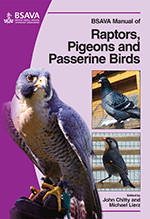
Full text loading...

Good organization is essential: prolonged attempts to capture a bird will cause additional stress (this is especially cruel for smaller and more critically ill birds, which more easily go into shock); and incorrect or clumsy attempts at restraint will put both bird and handler at risk of injury. This chapter advises the reader on capture and transport.
Handling and transport, Page 1 of 1
< Previous page | Next page > /docserver/preview/fulltext/10.22233/9781910443101/9781910443101.6-1.gif

Full text loading...











